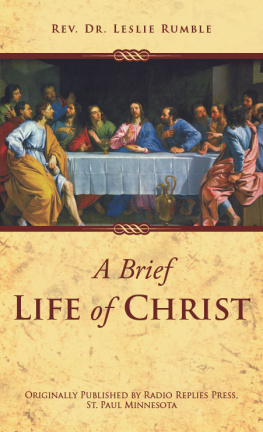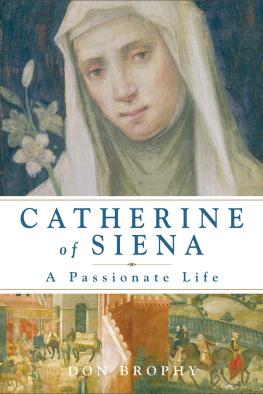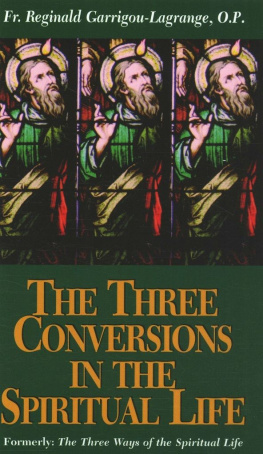The Life of St. Catherine of Siena
Raymond of Capua
| Nihil Obstat: | Daniel V. Flynn, J.C.D.
Censor Librorum |
| Imprimatur: | Francis Cardinal Spellman
Archbishop of New York
July 13, 1960 |
Copyright 1934 in the Italian edition by Dominican Prior of Siena.
Copyright 1960 in the English translation by Harvill Press and P. J. Kenedy & Sons.
Republished in 2003 by TAN Books. Re-typeset and republished in 2011 by TAN Books.
This translation has been made from S. Caterina de Siena. Vita Scritta dal B. Raimondo da Capua, Confessore della Santa . Tradotta dal P. Giuseppe Tinagli, O.P. Ezio Cantagalli, Editore in Siena (1934), and the Latin Bollandist text of 1860.
Cover illustration: Saint Catherine of Siena by Domenico Beccafumi, The Yorck Project.
Cover design by Milo Persic.
TAN Books
Charlotte, North Carolina
www.TANBooks.com
2011
THE LIFE OF
ST. CATHERINE
OF SIENA
Know, sweetest daughter, He said, that in the time to come your earthly pilgrimage will be distinguished by such marvellous new gifts from me that the hearts of ignorant carnal men will be amazed and incredulous... But you must not be anxious or afraid, for I shall be always with you, and I shall free your soul from the evil tongues and the lips that utter lies. Carry out undauntedly whatever the Spirit prompts you to do, for through you I shall snatch many souls from the jaws of hell and by my grace transport them to the kingdom of heaven.
Our Lord to St. Catherine, pages 150151
C ONTENTS
I NTRODUCTION
T HOUGH saints have sometimes been at loggerheads and, for instance, you would trust St. Jerome on St. Augustine no more than you would Manning on Newman, a special authority invests one saint when he does bring himself to write the life of another. Not that literary skill is guaranteed, but that, in the first place, informed sympathy with the heart of the matter can be expected, a response to what holiness is about, some account of the essential business which does not reduce it to the terms of a psychological case-history or substitute for it merely a natural, if unusual, reaction to the conditions of environment. Next, when the two have lived and prayed closely together, have followed the same daily round and undergone the same weather, have shared friends, acquaintances, and critics, have belonged to the same religious family and engaged in common enterprises, and, finally, have kept no secrets from each other, then you rightly look for an appreciation of the individual embodiment of holiness, together with the moods, the cast of countenance, and even the quirks that went with this falling and remaining in love with God.
Such is the recommendation for this biography, the translation of the Legend of Blessed Raymond of Capua (13301399), which is the main source for what we know about St. Catherine of Siena (13471380). He sprang from the nobility of the Regno , being descended from Peter delle Vigne, the famous chancellor of Frederick II, and was reader in theology at Siena when he took over from Thomas della Fonte, a fellow-member of the Dominican community there, the direction of Catherine Benincasa, the dyers daughter, a woman of twenty-seven already remarkable for her religious devotion and independent ways. Thomas, who may have felt that she was proving too much of a handful for him to manage, was self-effacing and made no fuss; later he supplied many of the recollections which were worked into the story Raymond had to be pressed to compose. Catherine herself was convinced that it was Our Lady who had sent this well-trained priest to be her confessor.
Presently he found that she was almost a full-time job, not only because of the spiritual questions she opened out, but also because she was a public figure, soon to move at the centre of international politics: her fame spread to England, and a century later Caxton printed the Lyf of St . Katherin of Senis . She had a profoundly theological habit of mind, and could not find enough time to dwell on the mystery of the Blessed Trinity. Always while she was acting as a welfare-worker at everybodys beck and call, fighting corruption, civil and ecclesiastical, pleading for peace, bringing back the Pope to Rome from his exile at Avignon, she yearned for the solitude where she could have occupied herself with meditation. It would have been an escape, for on taxing him whom she loved above all, Oh where were you, Lord, for seeming so terribly distant when she was disturbed by what she regarded as worse than distractions, his answer came, There was I, daughter, in the midst of them.
Raymond was to Catherine both father and son. Always obedient to him as a priest, sometimes impatient with him as a man, she might scold him and he in revenge might take advantage of his status and rap out orders like a pettish drill-sergeant. But she valued his advice and usually he was gentle with her and defended even her gaucheries. Oh Lord God, she once burst out, what kind of spiritual father is this you have given me, who finds excuses even for my sins! They were devoted to one another.
Their temperaments were very different. For she was like the Sienese winevery red. High-spirited and fearless, used to getting her own way where others were concerned, not one of a family of twenty-five with a bustling mother for nothing, devoid of human respect, generous in her loving and sometimes tart in its expression, it was remarked of her that she looked everybody in the face. One of the redoubtable women of history, she can be compared to St. Teresa among the yogis and Catherine of Russia among the commissars. Whereas one fancies that Raymond in appearance was a mousy little man. He suffered from ill-health, was constitutionally timid, somewhat prim and sensitive to scandal; occasionally he was puzzled by her behaviour and her projects could catch him lagging behind. Yet he was a reliable man of affairs, circumspect, a good negotiator, and he grew in stature from his friendship with her, and was ready to beard the fierce John Hawkwood, the Essex man turned condottiere, or to undertake risky journeys through the enemy lines. Prior of the Minerva at Rome when she died, he was afterwards elected Master General of his Order, in which office he died at Nuremberg during a visitation of the Germanies: some of his brethren judged that his reforming provisions neglected academic standards.
One endearing characteristic was a sense of humour about himself. Ingenuous and not given to self-esteem, he does not hesitate to tell a story against himself. Thus when he was Catherines impresario at Avignon he confesses how the affectation of piety by the ladies of that sophisticated court hoodwinked him because of their fine dresses and good looks. He leaves the impression of having been a truthful man, incapable of inventing stories or straining the evidence. On the other hand, he was no critical and detached observer. The dear reader he still takes into his confidence will be aware that his memories come stamped with conventions and clichs many of which have passed with the late Middle Ages. No doubt they were shared by his heroine, nevertheless one feels they are stiffened and stylized in his editing. He was no Boswell, and perhaps in portraying the saint he forgot the woman. As, after her death, he dismembered the loved body in accordance with the piety of the time, sending the head to Siena where it might be venerated, but discreetly for fear of the Roman populace, so also he seems to have tried to cut her personality to the cloth of the virtues. He did not succeed, for she speaks out of turn and, like a character in Shakespeare, breaks out of the part assigned to her; shedding the panoply, she gives a lift and a lilt to the lines of his catalogue.
This can scarcely be called prosaic, for it is full of odd happenings; Catherines own poise was not that which a humdrum psychologist would ascribe to a well-balanced personalityshe was too extravagant a giver for that. Here it is well to keep in mind the classical distinction drawn by theologians between sanctifying grace, the friendship with God taken to the pitch of holiness, and the miraculous gifts, gratiae gratis datae , which may or may not accompany it. These do not make a saint, though they may help towards canonization. They are given for the sake of others, for profit, ad utilitatem says the Vulgate, a means to an end says St. Thomas Aquinas; they are meant to draw attention to something else that really matters, the loving union of human beings with God. ( 1 Cor . 12:7). Since few hagiographers can feel that they have the knack of making holiness itself look interesting on paper, it is not surprising that they turn to the preternatural. Raymond does better than most, for the wonders he narrates always remain tributary to the main stream of his discourse.
Next page










